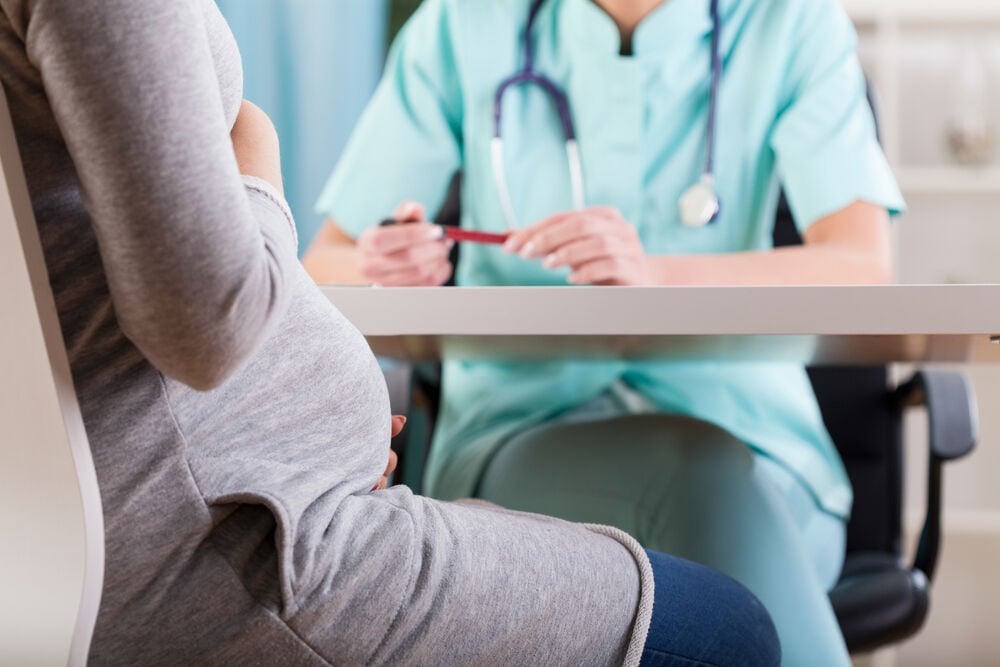Gonorrhea is a serious sexually transmitted infection (STI), and gonorrhea in pregnancy, when left untreated, results in major complications for both mother and baby. Next, learn more about how gonorrhea is contracted, proper treatment, and ways to prevent it.
-
Tracking cycle
-
Getting pregnant
-
Pregnancy
-
Help Center
-
Flo for Partners
-
Anonymous Mode
-
Flo app reviews
-
Flo Premium New
-
Secret Chats New
-
Symptom Checker New
-
Your cycle
-
Health 360°
-
Getting pregnant
-
Pregnancy
-
Being a mom
-
LGBTQ+
-
Quizzes
-
Ovulation calculator
-
hCG calculator
-
Pregnancy test calculator
-
Menstrual cycle calculator
-
Period calculator
-
Implantation calculator
-
Pregnancy weeks to months calculator
-
Pregnancy due date calculator
-
IVF and FET due date calculator
-
Due date calculator by ultrasound
-
Medical Affairs
-
Science & Research
-
Pass It On Project New
-
Privacy Portal
-
Press Center
-
Flo Accuracy
-
Careers
-
Contact Us
Gonorrhea in Pregnancy: What Every Mom Needs to Know


Every piece of content at Flo Health adheres to the highest editorial standards for language, style, and medical accuracy. To learn what we do to deliver the best health and lifestyle insights to you, check out our content review principles.
What is gonorrhea?
Also called “drip” or “the clap,” gonorrhea is an incredibly prevalent STI among sexually active individuals. According to CDC estimates, approximately 1.14 million new gonococcal infections occur in the U.S. each year.
Caused by the Neisseria gonorrhoeae bacterium, gonorrhea may be transmitted through oral, vaginal, or anal sex with an infected partner. It’s a highly contagious infection, easily spread from one person to another.
Following the incubation period, symptoms start to appear and last anywhere from 2 to 7 days after exposure. If you’ve developed gonorrhea in pregnancy (or prior to pregnancy) and do not seek medical attention, the infection could be passed onto your baby during delivery.
Gonorrhea affects both men and women, and in some cases, doesn’t produce any symptoms at all. That’s why early detection is critical. Get tested and treated quickly for gonorrhea if you believe you’ve been exposed recently.
Symptoms of gonorrhea in pregnancy
Despite the fact that a lot of women do not exhibit symptoms of gonorrhea, note that the most common signs include:
- Painful, burning urination
- Bleeding when you’re not menstruating
- White or yellow, unusual-looking vaginal discharge
- Pelvic or lower abdominal pain
- Painful intercourse
While the urethra is usually the site of infection for men, in women, it’s the cervix. Once attached, the bacteria spreads to other parts of your body.
If you’ve been infected somewhere other than your cervix or vagina, you might notice symptoms elsewhere. An anal infection, for example, would produce burning, itching, or pain during bowel movements. Oral infections of the mouth or throat lead to soreness, redness, and pain in those areas. Be very careful not to accidentally transfer the bacteria from your mouth to your eyes through touching or rubbing. Your eyes could begin itching, watering, or oozing a white or yellowish discharge.
Even in the absence of symptoms, if your partner has signs of gonorrhea, you should see your doctor right away. While waiting for test results and during the course of gonorrhea treatment, avoid all sexual contact. Once treatment’s complete, wait at least one week before having sex to avoid reinfection.
What happens when you have gonorrhea in pregnancy?
Your chances for miscarriage or preterm labor are greater when you’ve been diagnosed with gonorrhea in pregnancy. It’s also possible for your amniotic fluid and sac to become infected, causing preterm sac rupture (aka preterm premature rupture of the membranes or PPROM).
Furthermore, untreated gonorrhea makes you more susceptible to contracting other STIs, such as chlamydia and HIV. And it increases your likelihood of experiencing uterine infections post-delivery. Lastly, transmission of gonorrhea to your baby can occur during delivery as they come into contact with bacteria-infected genital fluids.
Your child would be prone to developing blood and joint infections, as well as eye infections or even blindness. Symptoms of eye infection take between 2 and 4 days to appear, and if ignored, might result in permanent blindness. This very serious complication can be prevented, however, by using antibiotic ointment as part of a routine newborn examination.
Of course, as always, the best method for treatment is prevention. If you suspect you may have gonorrhea in pregnancy, please seek testing and proper care to protect your health and the health of your baby.
Take a quiz
Find out what you can do with our Health Assistant
Treatment of gonorrhea in pregnancy

For your sake and your little one’s, consider testing for gonorrhea and other STDs early on in the pregnancy, if you’ve been exposed. Gonorrhea often progresses silently, demonstrating no symptoms until major problems arise.
To prevent spreading, early detection and prompt treatment are absolutely key. Experts recommend screening at least once during pregnancy if you’re at high risk for gonorrhea. (This typically occurs at your first prenatal visit with your ob-gyn.) Note these risk factors include prior STI or gonorrhea infections, sex with multiple partners, and failure to use protective measures like condoms.
For your sake and your little one’s, consider testing for gonorrhea and other STDs early on in the pregnancy, if you’ve been exposed. Gonorrhea often progresses silently, demonstrating no symptoms until major problems arise.
It’s also wise to get retested at any point in your pregnancy if you contract another STI or you or your partner show signs of gonorrhea. Testing for gonorrhea or other STIs entails swabbing your cervix and sending the sample to a lab. Your mouth or rectum may be swabbed as well if your doctor suspects these areas have been exposed to the bacteria. If results come back positive, gonorrhea treatment begins immediately.
The good news is that gonorrhea in pregnancy can be successfully addressed with antibiotics, whether orally or in the form of injections. It’s crucial to finish your medication, even if symptoms subside. Remember that your partner should also be tested and treated, and you’ll both have to avoid sexual contact for at least a week.
Antibiotics for gonorrhea in pregnancy
As the go-to weapon for battling gonorrhea in pregnancy, antibiotics could be administered as a one-time injection or taken orally.
One round of antibiotics is generally enough, unless you display persistent symptoms or have been infected for a longer period of time. A second round of antibiotics takes at least a week, and it’s important to stay in close communication with your doctor so they can monitor your progress.
Prevention of gonorrhea in pregnancy
Protect yourself from developing gonorrhea in pregnancy in the first place by taking the following preventive measures:
- Always use protection: While abstinence is clearly the most reliable, it’s not always realistic. Condoms are a highly effective form of protection that should be used for any type of sexual contact, including vaginal, anal, and oral.
- Abstain from sex with anyone showing symptoms: If you notice signs of gonorrhea in your partner such as painful urination, a genital sore or rash, avoid having sex.
- Ask your partner to get tested: If they haven’t been tested yet, see if they’re willing to get it done now. Then, wait till afterwards to resume sexual activity.
- Get yourself tested: Consider doing regular STI testing, at least yearly, perhaps during your routine gynecological exam. This is the recommended course of action both for individuals 25 years or younger and those older than 25 who are at greater risk. The recommendation also applies if you have a new partner, multiple partners, or a partner with an STI.
Takeaway
Contracting gonorrhea in pregnancy could have serious consequences if left untreated. Duration and effectiveness of treatment, however, depend heavily on early detection.
If you believe you’ve been exposed to gonorrhea or another STI, speak with your doctor right away. Testing is fast and simple, and antibiotics can be highly effective at protecting both you and your baby in the long run.


Hey, I'm Anique
I started using Flo app to track my period and ovulation because we wanted to have a baby.


The Flo app helped me learn about my body and spot ovulation signs during our conception journey.


I vividly
remember the day
that we switched
Flo into
Pregnancy Mode — it was
such a special
moment.
Real stories, real results
Learn how the Flo app became an amazing cheerleader for us on our conception journey.




